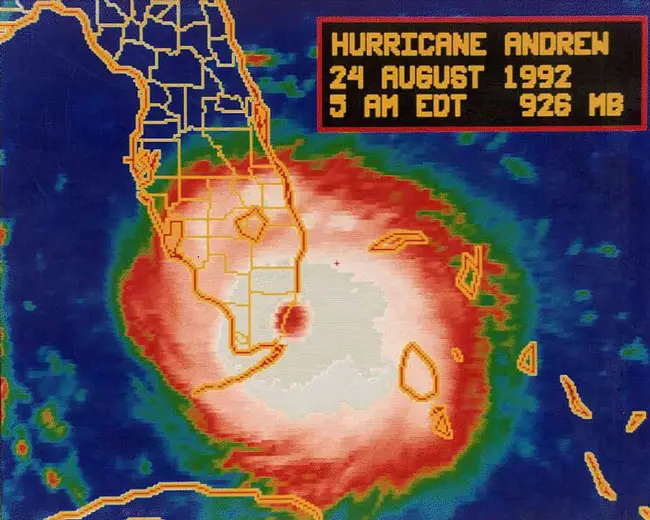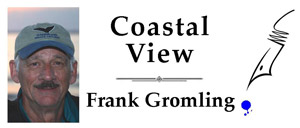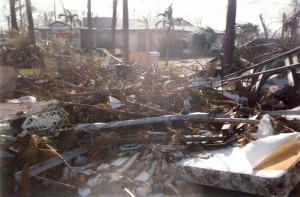
Note: this is the first of a three-part series by Frank Gromling marking the 20th anniversary of Hurricane Andrew’s landfall in Florida on Aug. 24, 1992. The second part, next week, will reexamine the storm’s destruction of his business, and the third will focus on lessons learned since.
![]()
I’m no stranger to hurricanes. Before I was 16 I had experienced three Category 3 hurricanes, one which would have killed me when I was 10 but for my brother’s saving grasp on my shirt.
 Living in Florida since 1967, I’ve been through several more hurricanes, including Hurricane Andrew on Aug. 24, 1992. When I realize it has been 20 years since Andrew came ashore in South Florida, I am struck by how fresh the memories are in my mind, how vivid the scenes are as they play in a mental movie that seems as real today as they were in 1992.
Living in Florida since 1967, I’ve been through several more hurricanes, including Hurricane Andrew on Aug. 24, 1992. When I realize it has been 20 years since Andrew came ashore in South Florida, I am struck by how fresh the memories are in my mind, how vivid the scenes are as they play in a mental movie that seems as real today as they were in 1992.
I’d like to tell you what it was like to live in a world without the daily essentials of life, but I will sum it up by asking you to imagine your life right now, right where you live, without a roof over your head, electricity, drinking water, food, ice, toilets, gasoline, security, emergency services, mail, and telephone. Then add in 90-degree temperatures and 80 percent humidity. Think of it this way: everything you enjoy today has been taken away and replaced by the unknown, the difficult and the stressful. And thousands of your neighbors are in the same circumstance, and will remain so for years to come.
That’s what it would be like to have lived through Hurricane Andrew. But it was actually worse than you can imagine. Just ask anyone who lived it. My wife Bibi and I did.
We bought our home in 1988 in an area of Dade County (now Miami-Dade) called Cutler Ridge, known for its large lots, fruit orchards, and old trees shading the roadways. Built in 1970, our home was a large one-story CBS (concrete block structure) with a pool on a three-quarter-acre lot blessed by palm, pine, avocado, mango, grapefruit and orange trees. We loved every day in this tranquil oasis from the active lives we led.
At 5 a.m. on August 24, 1992, all the peace we enjoyed was whirled into the unknown by something so innocently named Andrew.
Even though Andrew was projected to make landfall forty miles north of us, at the Dade-Broward County line, we left our home Sunday evening, Aug. 23, when authorities issued an evacuation order for all homes east of Old Cutler Road in south Dade. We lived on the west side of Old Cutler Road, but we didn’t think being on the other side of the road would protect us, so we headed to a friend’s home near Miami International Airport. We had done all we could to protect our home and possessions.
All but one of the most important.
In the four years we’d lived in the house, we had not yet installed hurricane shutters. We’d thought about it, talked about it, but simply deferred the decision to purchase other items on our list of improvements. Besides, we now rationalized, the storm wasn’t going to hit our area. It was going to the Broward-Dade line. After we returned home, we would finally get those expensive shutters.
As we slept at our friend’s home that night, Hurricane Andrew changed course, making a left turn to the west, heading straight for our home. At 5 a.m. the next day, Hurricane Andrew came ashore with 165 mph sustained winds and a 16.9-foot storm surge. It hit due east of our home, which was separated from the ocean water of Biscayne Bay by a quarter mile of trees and mangroves, none of which remained after the storm’s 3.5-hour landing ashore.
I remember watching the first reports on television and how I was reminded of scenes from old news clips of Hiroshima and Nagasaki – destruction so vast that nothing remained standing as far as the horizon. Helicopter news footage of south Dade County revealed devastation so complete that I recognized nothing.

Bibi and I set out about noon on the 24th to check on our properties, all three of which were in the heart of the storm’s path. As we drove south on the Florida Turnpike Extension, we could not believe our eyes. From the Bird Road (SW 40thStreet) intersection, and as far as we could see from the elevated roadway, there were no trees standing and every house was either destroyed or horribly damaged.
Traffic was building as others ventured out. Somehow I found the exit to where my business was located on SW 216th Street. There was no electricity, so stoplights did not work, if they existed at all. Stop signs and street signs were gone. Debris was everywhere, strewn about in a tangled mess of trees, vehicles, appliances, and roofs. Navigating the streets was a test of skill and nerves.
The building which housed my business was concrete block with a flat reinforced concrete slab roof. It was one of four identical structures I thought would withstand anything short of a bombing. I was wrong. Next week I’ll describe the experience of having one’s business smashed to pieces.
After inspecting a badly damaged townhouse Bibi owned and had under lease, we drove north on Old Cutler Road toward our home. With no signposts or familiar landmarks, and while driving around uprooted 100-year-old trees strewn across the road, we almost passed right by the place we had called home for four years. Nothing looked the same. Nothing.
While our exterior walls and concrete tile roof remained, everything else was destroyed. Where once had been a yard full of palms, pines, and fruit trees, now only eight small palms bravely stood guard while every other tree was either broken off or uprooted. The interior and exterior had become one, created by doors and windows removed by wind or storm surge, which we would learn was 16.9 feet at this very spot. Our front door elevation of 12 feet didn’t seem very high to us when we evacuated, and we were staring at the wisdom of that decision.
Bibi and I had left our two cats, Sergeant and Sasha, in the house when we left, but we hadn’t done as TV anchors had suggested, which was to put animals in a bathroom if you could not take them with you. When we realized that four feet of the ocean had roared through our home for an extended period, we were happy that the cats had been allowed to find safety somewhere in the house. Had they been in a bathroom, with nothing taller than the standard 34” counters, they likely would have tired and drowned. Sasha apparently rode out the storm on the family room sofa for when Bibi picked her up, Sasha peed for several minutes. Despite our calling him for over an hour, Sergeant was nowhere to be found. We thought we had lost him forever.
Bibi and I walked through the debris to determine if anything was salvageable. We saw remarkable demonstrations of natural power, as well as strange examples of how hurricanes can almost pick and choose what it destroys. In an area totally destroyed by wind and drenched in smelly muck from the bottom of Biscayne Bay, an etagère with crystal pieces stood upright and untouched.
My son Chance’s car, once in the garage, was now in the dining room. Our sunken living room, a favorite design feature of the 70s, held eight inches of dirty salt water, complete with seaweed, crabs and fish. Bibi’s vehicle, 150 feet away in a neighbor’s yard, was entrapped in tree limbs and ocean debris, a total wreck. But, while inspecting it a day later, we heard the mewing of a familiar voice. I pulled branches away from a huge pile to reveal a drenched and shaking Sergeant. Tears of joy replaced our tears of anguish.
For two days Bibi and I tried to restart our lives. Each time we attempted to clean up something, we ran into two or three other things that had to be done first. We never seemed to make any progress and the days ended with us returning to our friend’s home in a depressive mood we had never previously known.
On day three, the cavalry arrived in the form of friends and several associates from Bibi’s employer. With their collective help, we crashed through the barriers created by the tangled mess and started putting whatever we thought might be salvageable on the covered patio, which was now only slightly covered by a roof with huge holes. Although Andrew had been a fast moving and relatively small storm (it was 60 miles wide), it didn’t bring a lot of rain. Now, however, torrential rain began to soak our possessions, further rendering them worthless. With the exception of what we had taken with us for what we thought would be an overnight visit with friends, we had lost every material possession. But we hadn’t lost our spirit and our resolve. Our son Garrick came home on emergency leave from the Army and The Citadel allowed Chance to join us. We were safe, when others had died or been seriously injured during the storm.
We needed a place to live while we decided to rebuild or sell our home. With more than 25,000 homes destroyed and another 100,000 badly damaged, it would be two months before we’d finally meet our insurance adjuster.

With homes in north Dade in great demand, we found a home in Wilton Manors, a small suburb of Fort Lauderdale, and moved into a wonderful community of loving neighbors who took us into their hearts and kitchens. They couldn’t do enough for us and we will always be grateful for their kindnesses. The usual one-hour drive each way was doubled by construction traffic, but when we returned to our new home each night we were able to relax and enjoy our friends, who often brought us food and, perhaps as importantly, refreshing drinks of an alcoholic kind.
In part because we had already decided to move to Flagler County at some future point and to build our forever home there, we agreed to rebuild our Dade County home in what we called State Farm Construction School, a kind of self-help opportunity that would teach us how to build a home. Basically, except for the slab and exterior wall, restoring our home would be entirely the same as building a new home – framing, drywall, electricity, plumbing, flooring, exterior finish, roofing and so on.
For 26 months we lived in Wilton Manors, drove every week day to south Dade to oversee our reconstruction, and tried to have a life on the weekends. Even on Sundays we drove to Miami to go to the church we had attended since 1986. On November 17, 1994, we moved back into our home on Old Cutler Road. While the interior, exterior walls and roof were finished, the entire grounds, pool, patio and landscaping remained to do. We learned to love the eight little palms that had survived and came to think of them as symbols of strength. We knew that, in time, they would have other trees planted nearby to make the land and home the peaceful habitat it once had been before a storm named Andrew came ashore.
I’d like to tell you what it was like to live in a world without the daily essentials of life, but I will sum it up by asking you to imagine your life right now, right where you live, without a roof over your head, electricity, drinking water, food, ice, toilets, gasoline, security, emergency services, mail, and telephone. Then add in 90-degree temperatures and 80 percent humidity. Think of it this way: everything you enjoy today has been taken away and replaced by the unknown, the difficult and the stressful. And thousands of your neighbors are in the same circumstance, and will remain so for years to come.
That’s what it would be like to have lived through Hurricane Andrew. But it was actually worse than you can imagine. Just ask anyone who lived it.
Next week I’ll describe what it was like to have my business ripped apart and what went into putting it back together. I hope you join me and, before you do, spend some time checking your hurricane preparation list to make sure you are prepared for a hurricane.
Until next week, be well and do something positive to help nature.
![]()
Frank Gromling is the owner of Ocean Publishing in Flagler Beach. Reach him by email here.




























from miami says
I also wa in Miami when Andrew hit. I lived justt off of Quail Roost Drive and the Turnpike. I dont know what was shaking worse, me, my dog or the walls. NEVER again do I want to go thru something like that
Anonymous says
We still have the same place on Key Biscayne that survived. What was so strange is that Andrew blew right across the island and totally wiped out the lower one-mile or so. Leaving the lighthouse standing on what looked like a desert isle.
Trees, scrub, and those filthy racoons were all washed into Biscayne Bay! Except our small neighborhood. The path of destruction was like a bulldozer went through and left the northern portion. Amazing power of that storm.
PCer says
I grew up in Miami. We left my mother’s townhome in Kendall to stay at my grandmother’s home in South Miami Heights. We should have stayed in Kendall. Pure destruction everywhere. I still find it funny that many people refer to time as before Andrew and after Andrew in South Florida.
Devan says
How old were you when Andrew hit? Do you remember the street your grandma lived on in South Miami Heights. My family and I moved away from South Miami Heights summer of 1991, but my grandparents remained behind. Our houses were next door to each other before we moved and I remember them being completely totaled, though I can’t remember the name of the street we/they lived on.
Paddy says
My folks lived in Homestead and had my bro and I buy them an RV for them to live in while they were doing the reconstruction. This was about a month later, and coming down the freeway going into Homestead from Indiana every single palm tree that was left was bent almost in half. Amongst all the wreckage and debris, it was horridly Twilight Zone. Big hugs Frank,
gator fan 4ever says
i find it interesting that everybody that use to live in miami are like the people that used to live in new york…..everybody raves about it but nobody wants to live there….. i’ve been to both and wouldn’t give you a dime for either one.
PalmCoast says
Thank God you all had the strength to survive!…I am not sure I could have!!…TY Frank…GREAT story…many lessons could be learned here…leave when the gettin’ is good…hurricanes have a mind and destruction all their own!
Liana G says
I didn’t live in FL during Andrew. But did during Charlie, right in the eye — St Cloud. It was my first hurricane expericane, and I’m an island girl. I hope I never have to live through that again. My husband got stuck at work – they county had closed to draw bride – the only access to and from Hollywood Beach – before he could get out. He begged me not to go to a shelter unless absolutely necessary. He did once when he was little and living in SC. So myself and the 4 kids braved this hurricane in the downstairs half bath. The gods must have been smiling upon us. We survived. Should this ever happen again, I’m getting out of while the going is good! What doesn’t kill you make you stronger!!!
JL says
Great story! I remember flying into Florida from Idaho the day Andrew hit. They didn’t want to let us on the airplane because the hurricane was expected to hit. I told them nonsense, I was flying into Orlando, not South Florida. I remember the utter devistation. We helped collect water to send down to people. At least there was some good from this tragedy. The Hurricane codes were improved to make homes safer and to withstand more. Frank, I’m glad you and your family lived to tell about it.